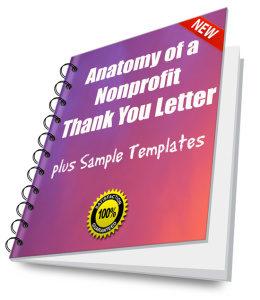 No doubt you know the donor thank you is important.
No doubt you know the donor thank you is important.
You may not fully grasp how important.
‘Thank you’ may be the most important element of your entire fundraising strategy.
I mean it!
Why?
Because effective fundraising depends on sustaining loyalty over time.
A one-time donor costs you money. Generally it costs $1.25 to acquire a new $1 donor. You’re not going to come out ahead unless you renew and upgrade that donor over time.
Alas, only 21% of first-time donors renew per the Fundraising Effectiveness Project. This results in leaky bucket syndrome where you’re constantly losing more than you’re winning. The only way to come out ahead is to stop the leaking.
I mean it!
Stop the Leaky Bucket
Never underestimate the power of ‘thank you’ to stop a bucket from leaking.
Donors leave because they don’t trust you.
Why should they if you don’t demonstrate to them how much they mean to you? And how much you want to partner with them to accomplish things they value? And how much you want to welcome them as a member of your community?
Trust is the foundation of any lasting relationship.
Gratitude kick starts the process of building relationships and establishes trust. You absolutely must embrace this powerful truth if you want more than one-time transactions.
How close are you to fully embracing this truth? Does any of this sound like your organization:
- People don’t really need a thank you. They’d rather we save the stamp.
- Too much gratitude makes people feel awkward; that’s not why they gave.
- I send a thank you when I get around to it.
- I delegate writing the thank you to the lowest-paid employee or, preferably, an intern.
- The thank you is written at the last minute, once gifts start arriving.
- The finance (not development) department sends a formal thank you with the receipt that can be used for tax purposes.
- One thank you is plenty.
- If people give online, they don’t also need a mailed thank you.
Maybe it’s because our parents drilled into us the need to say ‘thank you’ when we were kids. It felt forced. So now we’re still rebelling against our parents?
Time to grow up.
Cut the CRAP
Or, more to the point, cut the deck and deal out all the C.R.A.P. to your donors
C.R.A.P. is an acronym I created so you’ll remember the key elements of a thoughtful donor thank you practice.
- Creative
- Repeated
- Authentic
- Personal
Because it is a practice. It needs to be thoughtfully developed and nurtured to become a good habit. And that takes practice.
A thank you missing any of these four elements lacks the punch it needs to effectively do its most important job.
And that’s the job of making the donor feel connected to you in an overwhelmingly positive way. Side benefit? There’s plenty of research showing lots and lots of positive outcomes from both the giving and receiving of gratitude.
This is a practice that’s good for you and good for your donors.
It’s not difficult.
Not if you have the C.R.A.P. formula.
Ready?
1. Be Creative
Creation means origination.
Are your donor thank you letters original, or are you recycling the same old language every time?
Somehow fundraisers know they must capture the reader’s attention with an appeal letter, but then forget the same should hold true for a thank you letter.
If you think this doesn’t really matter, think again.
Among respondents to the Burk Donor Survey, 40% said receiving creative and engaging donor communications would make them much more likely to donate again.
Be careful here. Donors like thank you letters and phone calls. They don’t as much like thank you gifts. A lot is about perception. Donors want you to spend their philanthropy on the cause, not on engraved plaques. So give something simple, heartfelt, handmade, inexpensive and thoughtful. You can grab 72 ideas in my Creative Thank You’s.
2. Be Repeated
Frequency trumps recency.
You can’t just do it once then stop.
Gratitude, to be effective, must be repeated. It must be an ongoing practice, not a one-time thing. According to psychology research, a one-time act of thoughtful gratitude produced an immediate 10% increase in happiness and 35% reduction in depressive symptoms, but the effects disappeared within six months and three months, respectively. If you want to continue to feel satisfied in your work with donors (and, as a corollary, if you want your donors to stay uplifted by their philanthropy) you’ve got to practice gratitude as a way of life.
If you don’t, you’ll be like the typical charity and lose close to four-fifths of your annual donors between the first and second donation and up to 45% annually thereafter. Is that acceptable to you?
I certainly hope not!
It’s truly not that difficult to improve your retention and donor upgrade rates.
Simple gratitude is all it takes.
You’ll feel better, and your donors will too.
Gratitude is contagious! Nothing else will keep your donors in as continually a receptive mood.
3. Be Authentic
Don’t sweat it so much.
Research published in Psychological Science suggests people have a hard time writing a thank you note because it feels awkward to express thanks. So they struggle to find the right words. The researchers found as long as you’re authentic when expressing gratitude, you won’t come off poorly. All you have to do is think about what you’re thankful for.
Think. Jot that down.
- You helped us keep our doors open during the pandemic.
- You helped us rescue cute little kittens, just like Chester in the enclosed snapshot.
- You let kids like Mary know they’re not all alone in this world.
Chances are this will help you keep things simple and will avoid all the organization-centric jargon that tends to creep into thank you letters. Stuff that’s about numbers of people served, how much work is yet to be done, how many years you’ve been doing this work and other language that may belong in certain marketing materials but not thank you letters. Truly, a simple thank you can be super short and sweet.
The shorter it is, the more authentic it will seem.
4. Be Personal
Gushy is personal.
I’ve written frequently about the research done by Penelope Burk, author of Donor-Centered Fundraising. Consistently Burk’s findings show donors value thank you’s above all else. In fact in one Burk Donor Survey, 40% of respondents said they had received at least one thank you letter in recent memory they would describe as exceptional. Its “warm, personal tone making the letter feel like it was written just for me” was cited most often.
- 45% of donors said it was an outstanding thank you letter that inspired them to give again.
- 23% said they gave more generously because of the quality of the acknowledgement they received.
Network for Good surveyed thousands of recent donors to find out what would encourage them to give again. 41% said receiving personalized communication explaining the impact of their continued support would make them much more likely to consider donating again. A similar number said receiving creative and engaging donor communications would make them much more likely to donate again.
Why aren’t You Thanking More Thoughtfully?
Benefits from practicing gratitude include:
- People who practice gratitude are more sensitive to others.
- Gratitude leads to reciprocity.
- Gratitude strengthens and solidifies relationships.
- Gratitude enhances well-being.
- Gratitude is a strong motivator.
Surely you can see how all of the above would be useful in enhancing relationships with donors over time! And these are but a few of the benefits of gratitude practice. Truly, the list goes on and on. Check out some of the findings from 26 research studies on gratitude.
We absolutely know gratitude motivates positive behavior.
That’s your entire job as a fundraiser!
So… why aren’t you doing more of it?
- It’s a simple thing to do.
- It takes no special skills.
- It’s inexpensive.
- It packs a punch.
Additionally, you’ll likely be in more positive spirits once the thank you is sent!
Creative. Authentic. Frequent. Personal.
That’s it!
You’re likely out of practice.
In fact, we’re fast becoming a generation where expressing thanks, especially in writing, is becoming a lost art.
When’s the last time you wrote a thank you note to someone?
How do you think it would make you feel if you sent one?
When’s the last time you received one?
How do you think you would feel if you got one?
Thank you always, always feels good.
SIDE BENEFIT: After you’ve been thanking, thanking, thanking, you’ll feel much more pumped up and capable of making an ask! Really—I’ve seen this happen time and again when I’ve asked reluctant volunteer solicitors to begin with “thank you” calls. They graduate to solicitation calls in no time!
Okay, sold yet?
Practicing gratitude does not belong on the back burner.
Maybe you’re sold on the benefits, sort of, but then your practical (pressed for time) side says: Yeah, that makes sense I guess. But it’s a little bit kumbaya. Sure, it would be nice and all, but… who has the time, really? It can’t make that much of a difference. I’ll do that some day when I work someplace that is more fully staffed and resourced.”
Oh, dear.
Guess what?
You’ll never be more fully staffed and resourced if you don’t begin to fully embrace the power of thank you.
Want to Leverage the Power of Thank You?
 Grab Anatomy of A Nonprofit Thank You Letter Plus Sample Templates. This is a simple, step-by-step guide to crafting a killer donor thank you letter. Once you master this technique you’ll be lightyears ahead of the competition. It still confounds me how many thank you letters I receive, even from large and well-established organizations, which are simply dreadful.
Grab Anatomy of A Nonprofit Thank You Letter Plus Sample Templates. This is a simple, step-by-step guide to crafting a killer donor thank you letter. Once you master this technique you’ll be lightyears ahead of the competition. It still confounds me how many thank you letters I receive, even from large and well-established organizations, which are simply dreadful.
If you want to develop a full-fledged donor gratitude and retention practice, grab the Donor Retention and Gratitude Playbook. It includes the thank-you letter book + templates as well as 5 other complementary volumes to help you retain, upgrade and keep your donors for life! You’ll get practical tips, worksheets, exercises, templates, samples and checklists. Taken together they’re a comprehensive “Donor Retention Bible” you will refer to over and over again.
All Clairification products come with a 30-day, no-questions-asked, 100% refund guarantee. You can’t lose.
Photo by Yoav Hornung on Unsplash






I began doing this many years ago, and for a long time wasn’t sure of its value. I would also write of a recent event or success that was a credit to their support.
One day in conversation with a donor, the subject of my notes came up. She said to me, “I love your notes, and have them all saved in a shoebox”.
‘Nuff said.